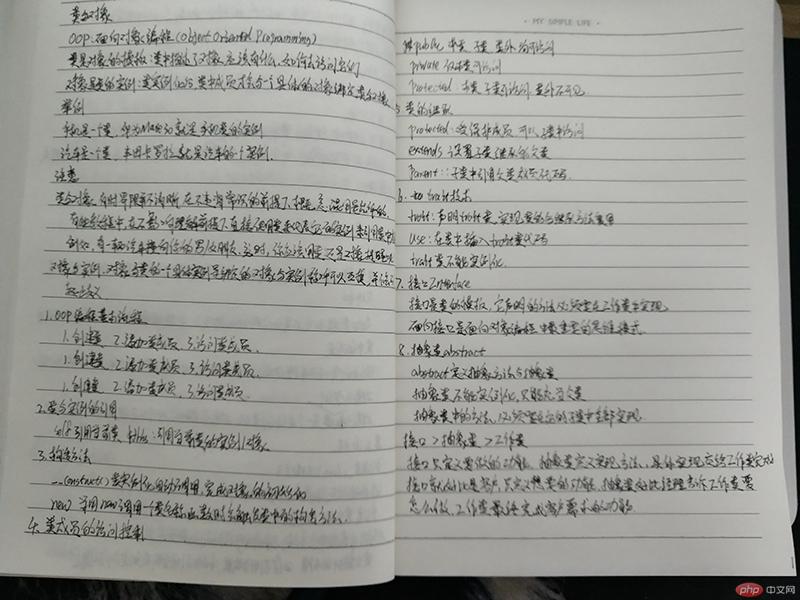创建类与构造函数
// 1.创建类class Demo1{
// 2.添加类成员
// 在类中的变量和函数,和程序中的变量与函数有区别,添加了访问限制符
// 变量=>类的属性,函数=>类的方法,定义:访问限制符 成员
public $name='Ricky';
public function getName(){// 第一步,类的实例化
$obj=new Demo1;
return 'Hi, ' . $obj->name;
}}// 3.访问类成员$obj = new Demo1;//访问属性:对象成员访问符 " -> "echo $obj->name . '<br>';echo $obj->getName() . '<br>';//创建类class Demo2{// 2.添加类成员
public $name = 'Ricky';
public $occupation='Programmer';
public function getInfo(){// 类的实例化引用 $obj = new self 等同于 $this;
return 'Name:'.$this->name.' Occupancy:'.$this->occupation;
}
public function getOccupation(){
return 'Your occupation is ' . $this->occupation;
}}$obj2 = new Demo2;echo $obj2->getInfo().'<br>';echo $obj2->getOccupation().'<br>';// 构造函数class Demo3{
public $name;
public $occupation;
public function getInfo(){
return 'My name is ' . $this->name . ' and occupation is ' . $this->occupation. '<br>';
}
public function __construct($name,$occupation)
{
$this->name = $name;
$this->occupation = $occupation;
echo $this->getInfo();
}}$obj3 = new Demo3('Ricky','Programmer');// __get()魔术方法,检查匹配类中属性class Demo4{
public $name;
protected $occupation;
public function getInfo(){
return 'My name is ' . $this->name . ' and occupation is ' . $this->occupation.'<br>';
}
public function __construct($name,$occupation)
{
$this->name = $name;
$this->occupation = $occupation;
}
public function __get($name){ // 匹配类中的属性
$userRole = $_GET['role'] ?? '';
if(isset($userRole) && $userRole === 'admin'){
return isset($this->$name) ? $this->$name : 'Undefined';
}else{
return 'Forbidden Visit';
}
}}$obj4 = new Demo4('Ricky','Programmer');echo $obj4->rold; // 访问不存在属性//类的继承class Demo5{
public $name;
protected $occupation;
public function getInfo(){
return 'My name is ' . $this->name . ' and occupation is ' . $this->occupation.', ';
}
public function __construct($name,$occupation){
$this->name = $name;
$this->occupation = $occupation;
}}class Demo5_1 extends Demo5{
private $age;
public function __construct($name, $occupation,$age)
{
parent::__construct($name, $occupation);
$this->age = $age;
}
public function getInfo()
{
return parent::getInfo() . 'I\'m '.$this->age.' years old.';
}}// 访问类成员$obj5 = new Demo5_1('Ricky','Programmer','28');echo '<br>'.$obj5->getInfo();// trait: 代码复用方式,用来扩展当前类的功能// trait: 当成一个公共方法库trait First{
public function getInfo(){
return 'My name is ' . $this->name . ' and occupation is ' . $this->occupation.'<br>';
}}class Demo6{// 导入trait类库
use First;
public $name;
public $occupation;
public function __construct($name,$occupation){
$this->name = $name;
$this->occupation = $occupation;
}}class Demo6_1 extends Demo6{
private $age;
public function __construct($name, $occupation,$age)
{
parent::__construct($name, $occupation);
$this->age = $age;
}
public function getInfo()
{
return parent::getInfo().'I\'m ' . $this->age . 'years old';
}}$obj6 = new Demo6_1('Ri1cky','Programmer','28');$obj6->getInfo();Trait方法
// trait: 代码复用方式,用来扩展当前类的功能// trait: 当成一个公共方法库trait First{
public function getInfo(){
return 'My name is ' . $this->name . ' and occupation is ' . $this->occupation.'<br>';
}}class Demo6{// 导入trait类库
use First;
public $name;
public $occupation;
public function __construct($name,$occupation){
$this->name = $name;
$this->occupation = $occupation;
}}class Demo6_1 extends Demo6{
private $age;
public function __construct($name, $occupation,$age)
{
parent::__construct($name, $occupation);
$this->age = $age;
}
public function getInfo()
{
return parent::getInfo().'I\'m ' . $this->age . 'years old';
}}$obj6 = new Demo6_1('Ri1cky','Programmer','28');echo $obj6->getInfo();接口的定义与实现
//1.创建类interface iDemo{
//接口方法
public function getInfo();
public function hello();}//工作类class Demo7 implements iDemo{
public $name;
protected $occupation;
public function getInfo(){
return 'My name is ' . $this->name . ' and occupation is ' . $this->occupation.'<br>';
}
public function hello(){
return 'Hello everyone.';
}
public function __construct($name,$occupation)
{
$this->name = $name;
$this->occupation = $occupation;
}}$obj = new Demo7('Ricky','Programmer');echo $obj->getInfo();echo $obj->hello();抽象类定义与实现
// 抽象类:有抽象方法,也是已实现的方法// 接口全是抽象方法// 共同之处:统统不能实例化,原因是内部有抽象方法//1.创建类interface iDemo{
//接口方法
public function getInfo();
public function hello();}abstract class AbsClass{
// 抽象方法
abstract public function getInfo();
// 已实现方法
public function hello(){
return 'Hello everyone.';
}}//工作类class Demo8 extends AbsClass {
public $name;
protected $occupation;
public function getInfo(){
return 'My name is ' . $this->name . ' and occupation is ' . $this->occupation.'<br>';
}
public function hello(){
return 'Hello everyone.';
}
public function __construct($name,$occupation)
{
$this->name = $name;
$this->occupation = $occupation;
}}$obj = new Demo8('Ricky','Programmer');echo $obj->getInfo();echo $obj->hello();总结
1.抽象类与接口,都是定义执行方法,具体实现代码写在工作类中,扩展抽象类使用
extends,扩展接口使用implements,通常使用抽象类来实现接口,用工作类实现抽象类,抽象类一旦被继承,其中的所有抽象方法必须在子类中全部实现。2.Trait主要解决了继承代码复用的问题,比如多个子类要继承多个父类的方法,就可以使用Trait把方法写入,在子类中使用
use Trait来调用该方法。


